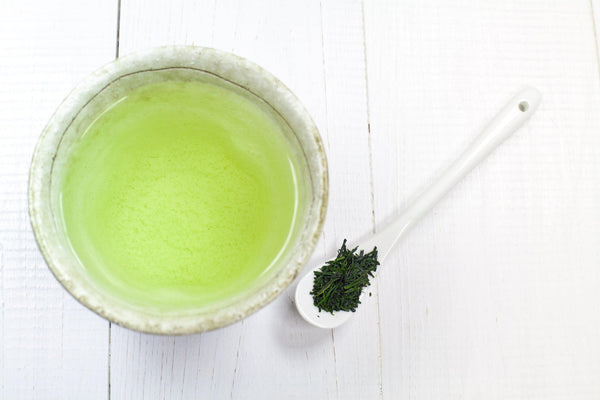
Jump to:
If you feel like royalty when enjoying the exquisite sweetness of Gyokuro Japanese tea, it may be because you are enjoying a variety of tea that was originally served exclusively to the Emperor!
Although us commoners can also enjoy Gyokuro these days, it still maintains its reputation as a high-class tea that tends to be drunk on special occasions, and it comes with a matching price tag to boot.
So, what is so special about Gyokuro, and what, if anything, about it justifies its elite status?
Origins Of Gyokuro

Seeing as Gyokuro is made from the Camellia sinensis plant like all other green and black teas, what is it that sets it apart? To answer that question, it may be instructive to look at its origins.
Although the history of Japanese tea drinking is said to date back to the 8th Century, the story of Gyokuro is less than two centuries old. Different Japanese tea types have been developed through a process of trial and error and are often hit upon by accident while trying to solve some other problems. Gyokuro is no exception.
A tea producer, Yamamoto Kahei, when traveling around Japan in 1835, found farmers in Uji that covered the tea plants to protect them from the cold. He discovered that this made the tea both smoother and sweeter. When applying this to his own tea, he found that there was a green residue left on these shaded plants and so he named the tea Gyokuro (literally, “Jade dew”).
As the shading of the plants is an important element in both the taste and nutritional profile of Gyokuro, let’s take a closer look at what exposing, or in this case not exposing, tea leaves to the sun actually does.
A Shady Character

Many people have the image of green tea as a very bitter drink, and, of course, it certainly can be. The bitterness or astringency in green tea is caused by the presence of phenol compounds known as catechins, which are produced by the plant as a protective measure against UV light.
Saying they are produced, however, maybe a little misleading. An amino acid called L-theanine, which has a sweeter taste, is converted into catechins as it is exposed to the sun. What those farmers in Uji hit upon, when protecting their plants from the cold, was also a way of keeping the taste of the tea sweet by preventing the chemical conversion process to catechins.
In the case of Gyokuro, the leaves are shaded for approximately three weeks before harvesting and only the top three leaves of the plant are used. This means that not only are only the youngest and sweetest tea leaves are used, but the maximum amount of the sweeter L-theanine compounds are retained.
Why Is Gyokuro So Pricey?

Gyokuro can be thought of as like the Blue Mountain of the green tea world, and prices can range from the high to the scary side. So, what is it about Gyokuro that makes it so expensive to produce?
One reason is that the process of making Gyokuro is a lot more labor-intensive than other green teas. As already discussed, the leaves need to be covered and these coverings need to be erected manually. Next, during harvesting, only the top three leaves of the plant are used, and this selective process means that the leaves are often hand-picked, which further increases labor costs. There is also an extra rolling process after the leaves are steamed and dried, in which the leaves are rolled with a series of brushes. This gives Gyokuro its tightly rolled needle-like appearance.
And there is the harvesting period itself. Gyokuro tea leaves are only picked during the “Ichibancha” first harvesting season between April and June, after which the tea plants and soil are allowed to rest in preparation for the next year’s harvest. This limited availability and restrictive use of the farmer’s resources also drives up the price.
Gyokuro – The High Caffeine Green Tea

Gyokuro can be at least as high in caffeine as a strong cup of coffee. Although generally lower in caffeine than Matcha, where the caffeine is concentrated by being ground into a fine powder, it is the highest in caffeine among the leaf-based green teas. So why is it so high in caffeine?
To answer this question, we need to look at why plants have caffeine in the first place. Caffeine production is a defense mechanism used by the tea plant to make it distasteful to insects. As the younger tea plants used by Gyokuro are particularly enticing to the bugs, the plant produces a correspondingly large amount of caffeine to deter them. The long shading process also places the plants under stress, which also boosts the amount of caffeine produced.
Gyokuro is generally served at slightly cooler temperatures, with a higher ratio of leaves to water, and in small cups, which makes the experience more akin to an espresso shot than drinking a hot cup of tea.
Although supplying an energy boost like espresso, Gyokuro aficionados claim the caffeine experience is different from that of coffee, as we will look at in the next section.
The Gyokuro Caffeine Experience

Of course, depending on your perspective, and indeed body makeup, being high in caffeine may be considered either an advantage or a disadvantage.
Earlier, we looked at how the shading process prevents the l-theanine compounds from being converted to catechins. L-theanine is an amino acid that has been shown to have an effect on alpha brain waves, aiding relaxation and stress management. Gyokuro devotees assert that the energy boost provided by Gyokuro is smoother and longer lasting than the jittery, surge, and crash effect experienced with coffee.
The potential benefits of combining caffeine and l-theanine have not escaped the attention of the scientific world. A 2010 report published in the National Library of Medicine on a randomized trial looking at the combination of caffeine and l-theanine concluded that it improves cognitive performance and increases subjective alertness. This might just make Gyokuro the most natural (and legal) performance-enhancing drug out there.
Is Gyokuro The Healthiest Green Tea?
So, is Gyokuro healthier than other green teas? This is a highly nuanced question and there is no right answer. It really depends on what health benefits you are looking for in your green tea.
Certainly, in today’s busy world, tea that has the ability to give you an energy boost while providing relaxation and freedom from anxiety has a lot going for it. On the other hand, the catechins, of which the production is highly suppressed in Gyokuro, are antioxidants that also have a whole host of health benefits. Older tea leaves also have more minerals than would be found in Gyokuro.
The bottom line is that all green tea is super healthy, and by consuming a wide variety of different types you can get different nutritional benefits with each kind and your body can truly experience the best of all worlds.
Preparing Gyokuro

When preparing Gyokuro, it is better to use water-cooled to between 50-60 degrees Celsius as this allows the umami taste to be drawn out without astringency, which tends to come out when using hotter water. The tea is also brewed for at least two minutes to extract all of the flavor from its tightly packed leaves.
If you have a water server that can be set to a specific temperature, this is one way of getting water that is hot enough, but not too hot, for Gyokuro. Other methods involve a process of moving the boiled water between cups, the Kyusu pot, and a cooling receptacle (called a Yuzamashi) to bring it to the perfect temperature.
This technique needs practice, however, and the art is getting the water cool enough to bring out the best flavor in the tea without it being tepid by the time it is finally poured into the cups.
The Brewing Process
Although recommendations on how to brew the best Gyokuro differ, a sample procedure is given below:
- Pour the approximate amount of boiling water for all servings into the Kyusu pot (recommended 40-50 cc per person)
- Pour the water into the cups to be used for serving. Discard any leftover water
- Put 5g of Gyokuro per person into the teapot
- Pour the water from each cup into the Yuzamashi receptacle
- Move the (now cooled) water from the Yuzamashi to the Kyusu
- Leave the tea for two minutes to brew
- Pour evenly between the cups to achieve a consistent strength
Foods Gyokuro Pairs Well With

The umami and savory notes in Gyokuro mean that it pairs well with seaweed and other foods high in umami. These include foods such as tuna, oysters, soy sauce, and shiitake mushrooms.
This high umami content of Gyokuro means that it also pairs well with dark rich chocolate, and its sweetness means that it also is a good match for the natural sweetness of dried fruit.
A Food In Itself
In addition to pairing well with other foods, did you know that Gyokuro can become a food in itself? In fact, a growing number of Gyokuro proponents are getting more bang for their buck by eating the leaves as well after brewing the tea.
One reason that Gyokuro is considered a good type of tea leaf to eat is that, coming from the younger leaves of the plant, Gyokuro leaves have a soft and smooth consistency, akin to something like steamed greens.
Eating the leaf, of course, means that you get all the nutrients of the compounds in the leaf, rather than just the ones that are extracted by the water. This brings it to par with Matcha, where everything is ground and consumed. As in the case of Matcha, however, it is probably wise to only eat organically produced tea leaves.
Ways of eating the leaves include adding a dash of soy sauce and some Katsuobushi bonito flakes or with a little rock salt to make a healthy and satisfying appetizer or eating them in the form of O-chazuke with rice.
Where To Buy Gyokuro?
Although it is possible to find Gyokuro tea bags, Gyokuro’s elite status means that it is most commonly only found in loose-leaf form, and in specialist tea shops and online stores rather than supermarkets.
A Special Kind Of Green Tea

While some Japanese tea drinkers may be put off by the high price tag of Gyokuro, rather than being based on any “snob value”, this reflects the extra care and select use of resources that goes into producing it.
Although somewhat expensive to enjoy as your staple green tea on a daily basis, it definitely has its place as a drink for special occasions, or when you want to try something a bit different.
Have you tried Gyokuro yet? Do you get what all the fuss is about, or is it not your cup of tea? Please let us know in the comments.


0 comments